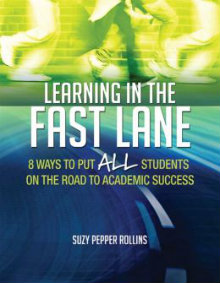On the Fast Road to Academic Success
Learning in the Fast Lane: 8 Ways to Put All Students on the Road to Academic Success
By Suzy Pepper Rollins
(ASCD, 2014 – Learn more)

Learning in the Fast Lane: 8 Ways to Put All Students on the Road to Academic Success by Suzy Pepper Rollins was a fantastic summer read for me—I actually read through it twice, have consulted it numerous times since then, and shared ideas from it with a couple of co-workers during our back-to-school planning.
My copy is thoroughly highlighted and annotated for ease of finding the best stuff! (This is a perfect segue for classroom use: I learned a new term—highwriting—“When a reader decides that something is important enough to highlight, he or she makes a note in the margin summarizing the highlighted point.”) Highwriting is just one of Rollins’ numerous ideas I plan to implement in my reading classes.

Plentiful research
What struck me most about Rollins’ book was all of the research references included. I don’t know if this is standard for ASCD-published books, but it certainly stood out to me. Recently I’ve been reading books on student brain research regarding best instructional practices, and much of what I’ve read is included in Rollins’ book.
Our district has been trained by Jane Pollock (an ASCD author, researcher, and presenter), and this book is a perfect fit with the GANAG method of planning we use. Chapter 3, for example, focuses on “success starters” to immediately engage kids with the material, as opposed to warm-ups or bell-ringers. Our building is also beginning implementation of Danny Hill’s ICU program to defeat student apathy, and many of Rollins’ ideas fall into place with it, as well.
Fresh ways to assess
The chapter that struck me most was the one on formative assessment. Last year I jumped head first into standards-based grading, and this chapter not only reaffirmed what I was already doing, but it also introduced me to some new ideas for feedback and assessment (new uses for sticky notes!). I am betting her “bow tie” tool will become a favorite of both mine and my students. There were so many great ideas for gauging student understanding—and I am thankful to have all of these new tools at the ready instead of using my same old go-tos.
I also loved the chapter on student motivation. Toward the end of last year I really started thinking about student engagement—hence the brain research interest—and this chapter really gives the background for how students’ self-efficacy, stress, extrinsic motivation (L), and more play into engagement. Again, research is prevalent in Rollins’ every chapter, giving readers the science behind the strategies.
A thorough approach to the Common Core
The one idea I’d like to try, but feel the least competent to implement right now, is the standards wall. For me, it means getting down and dirty with the CCSS for reading—even more so than I already am. However, I think it will ultimately help clarify the standards in my mind, not to mention the busy brains of my students. I am just going to have to dig in and do it, and I like getting all up in something new and kind of scary. Thankfully, Rollins identifies the steps in the process and its components: the concept map, a TIP chart (vocabulary), and student work.
Bottom line: Is Learning in the Fast Lane worth its list price? The straight answer? It depends. If, like me, “research-to-back-it-up” is important, then YES, this book may be a great fit. I love, love, love the research behind Rollins’ strategies, and I truly believe that most of her ideas are practical and can easily be implemented in the classroom. Note—I did check another review source after writing this, and all (5) of the reviews I read were positive.
Carolyn Miller is entering her 24th year in education, the last 17 of which have been in middle school. She holds a master’s degree in education and a Reading Specialist endorsement. Fall begins her eighth year teaching 7th grade reading. Carolyn is an avid reader of professional development books, articles, and blogs, as well as young adult literature. She also loves the advent of Twitter and Pinterest for in-the-moment thoughts and teaching ideas. She believes it’s a great time to share and learn for teachers!

































